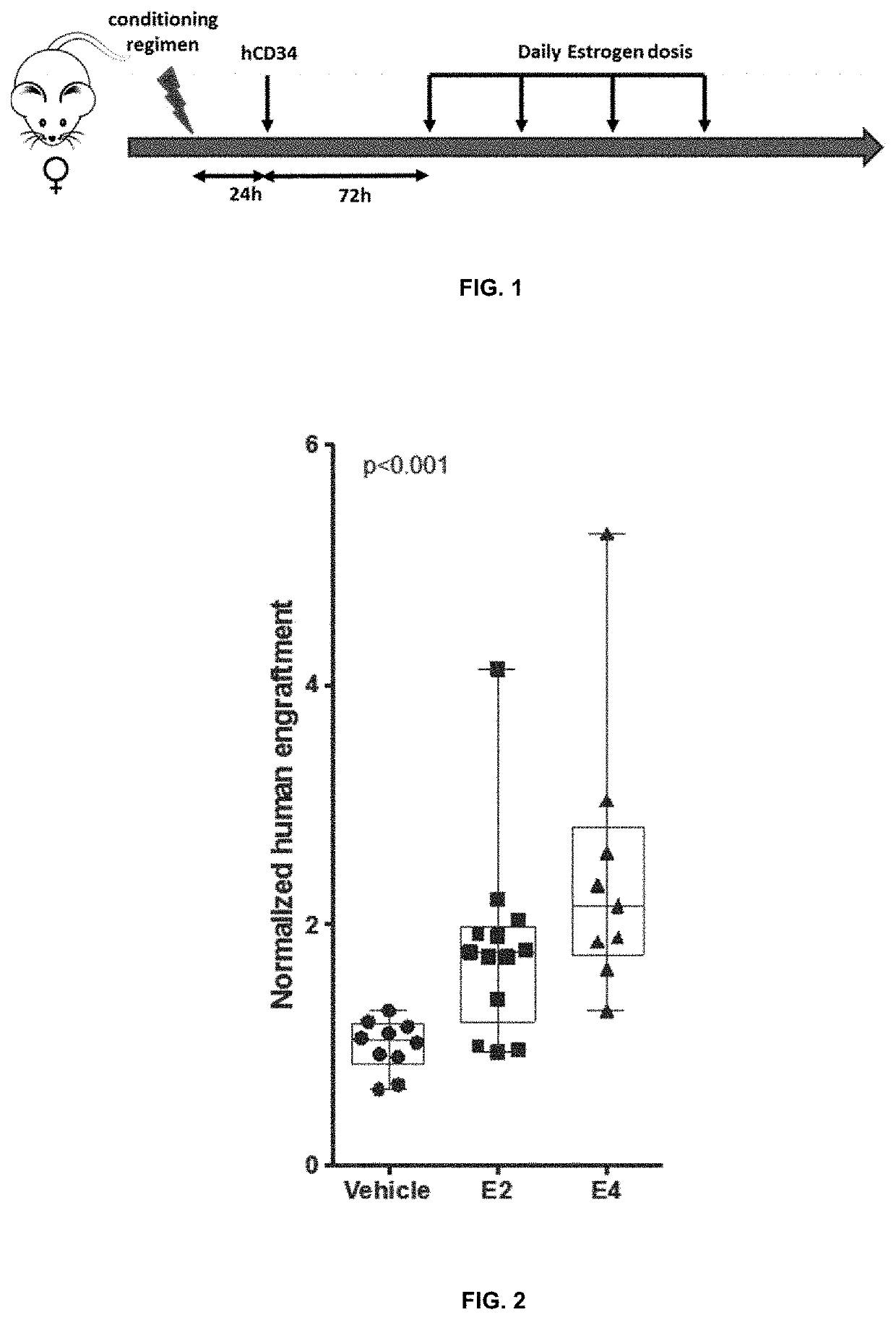Improvements for performing and facilitating the recovery after hematopoietic stem cell transplantation
a hematopoietic stem cell and transplantation technology, applied in the field of enhancing hematopoietic recovery after hematopoietic stem cell transplantation, can solve the problems of limited hsc long-term repopulation capacity, shortage of hsc donor, hsct failure, etc., and achieve the effect of enhancing hematopoietic reconstitution
- Summary
- Abstract
- Description
- Claims
- Application Information
AI Technical Summary
Benefits of technology
Problems solved by technology
Method used
Image
Examples
example 1
of Hematopoietic Reconstitution after Hematopoietic Stem Cell Transplantation
[0065]Male immunodeficient NSG mice were irradiated by 2.2 Gy and transplanted by 5×104 human cord-blood CD34+ cells twenty four hours later. 72 hours later, the transplanted animals were treated with either 2 μg of estrogen or vehicle (olive oil) daily for four days. Three-four months later, the animals were sacrificed and the human hematopoietic engraftment was analyzed by FACS. Human hematopoietic population was identified as the cells positive for hCD45-APC-Cy7 (Biolegend) and negative for mouse CD45.1-PE (Biolegend).
[0066]Estrogen or vehicle treated animals were compared. The results are shown in Table 1:
TABLE 1Percentage of human hematopoietic reconstitution(mean + / − standard error of the mean and number of mice)Vehicle26.70 + / − 4.19 (n = 10)E246.05 + / − 5.98 (n = 13)E447.47 + / − 6.08 (n = 9)
[0067]Additionally, human multilineage reconstitution of these animals was analyzed. The results are shown in Ta...
example 2
Raises Hematopoietic Stem Cell Compartment in Human Hematopoietic Engraftment
[0069]In order to further examine the effect of the estrogen in HSCT, hematopoietic progenitors (hCD34+) and hematopoietic stem cells (hCD34+ / hCD38−) were analyzed by FACS inside of the human population in the treated NSG described in Example 1. The results are shown in Table 3.
TABLE 3Percentage in the human hematopoietic population(mean + / − standard error of the mean and number of mice)hematopoietichematopoieticprogenitorsstem cellsVehicle7.22 + / − 1.00 (n = 8)0.39 + / − 0.08 (n = 8) E2 9.35 + / − 0.86 (n = 13)0.52 + / − 0.07 (n = 13)E413.94 + / − 0.85 (n = 11)0.87 + / − 0.11 (n = 11)
[0070]Moreover, to study the long-term effect in HSCT, human CD45+ cells were sorted and transplanted in secondary irradiated female NSG mice. Three months after the secondary transplant, human hematopoietic engraftment was detected in all the animals transplanted with cells from estrogen treated primary mice.
[0071]Thus, estrogen treatme...
example 4
Increases Human Progenitors in an In Vitro Human Bone Marrow-Like Culture
[0075]To further investigate the beneficial effect of the estrogen in human HSCT, human bone marrow-like cultures, such as LTC-IC culture, were established. 1×105 human mesenchymal stromal cells (hMSC) were seeded in a p6 well and irradiated with 30 Gy next day. The following day, 5×104 hCD34+ were added to the hMSC in LTC-IC media: 75% α-MEM without Phenol Red (Life Technologies), 12.5% Hyclone FBS (GE Healthcare), HS (Life Technologies), β-mercaptoethanol (Life Technologies), 0.5% PS and 1×10−6 M Hydrocortisone (Sigma-Aldrich). 100 μM of estrogens, dissolved in ethanol, was added to the co-culture for a week, and then the cells were collected and the amount of human hematopoietic progenitors were evaluated in semisolid media supplement with specific hematopoietic cytokines (H4535, StemCell Technologies) plus 8 U / ml hEPO. After fourteen days, colony-forming units (CFU) were evaluated and normalized to the cont...
PUM
| Property | Measurement | Unit |
|---|---|---|
| concentration | aaaaa | aaaaa |
| concentration | aaaaa | aaaaa |
| concentrations | aaaaa | aaaaa |
Abstract
Description
Claims
Application Information
 Login to View More
Login to View More - R&D
- Intellectual Property
- Life Sciences
- Materials
- Tech Scout
- Unparalleled Data Quality
- Higher Quality Content
- 60% Fewer Hallucinations
Browse by: Latest US Patents, China's latest patents, Technical Efficacy Thesaurus, Application Domain, Technology Topic, Popular Technical Reports.
© 2025 PatSnap. All rights reserved.Legal|Privacy policy|Modern Slavery Act Transparency Statement|Sitemap|About US| Contact US: help@patsnap.com



